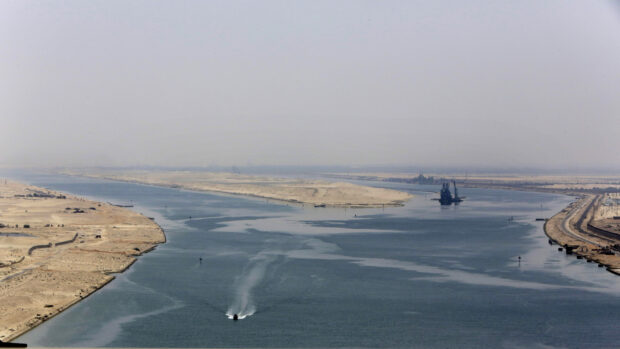
UNITED NATIONS — The U.N. trade body sounded an alarm Thursday that global trade is being disrupted by attacks in the Red Sea, the war in Ukraine, and low water levels in the Panama Canal.
Jan Hoffmann, a trade expert at the United Nations Conference on Trade and Development known as UNCTAD, warned that shipping costs have already surged and energy and food costs are being affected, raising inflation risks.
Since attacks by Yemen’s Houthi rebels on ships in the Red Sea began in November, he said, major players in the shipping industry have temporarily halted using Egypt’s Suez Canal, a critical waterway connecting the Mediterranean Sea to the Red Sea and a vital route for energy and cargo between Asia and Europe.
The Suez Canal handled 12 percent to 15 percent of global trade in 2023, but UNCTAD estimates that the trade volume going through the waterway dropped by 42 percent over the last two months, Hoffmann said.
Houthis attacks
Since November, the Iranian-backed Houthis have launched at least 34 attacks on shipping through the waterways leading to the Suez Canal. The Houthis, a Shiite rebel group that has been at war with a Saudi-led coalition backing Yemen’s exiled government since 2015, support the Palestinians and have vowed to keep attacking until the Israel-Hamas war ends.
READ: US, Britain carry out strikes vs Houthis in Yemen – officials
The United States and Britain have responded with strikes against Houthi targets, but the rebels have kept up their attacks.
Hoffmann, who heads the trade logistics branch at Geneva-based UNCTAD, told a video press conference with U.N. reporters that the Houthi attacks are taking place at a time when other major trade routes are under strain.
Ukraine-Russia conflict
The nearly two-year war since Russia’s Feb. 24, 2022 invasion of Ukraine and other geopolitical tensions have reshaped oil and grain trade routes including through the Black Sea, he said.
Compounding difficulties for shipping companies, Hoffmann said, severe drought has dropped water levels in the Panama Canal to their lowest point in decades, severely reducing the number and size of vessels that can transit through it.
READ: Drought-hit Panama Canal to restrict access for one year
Total transits through the Panama Canal in December were 36 percent lower than a year ago, and 62 percent lower than two years ago, Hoffmann said.
Ships carry around 80 percent of the goods in world trade, and the percentage is even higher for developing countries, he said.
Risk to food security
But the Red Sea crisis is causing significant disruptions in the shipment of grains and other key commodities from Europe, Russia and Ukraine, leading to increased costs for consumers and posing serious risks to global food security, Hoffmann said.
This is specially true in regions like East Africa, South Asia, Southeast Asia and East Asia, which heavily rely on wheat imports from Europe and the Black Sea area, he said.
Hoffmann said early data from 2024 show that over 300 container vessels, more than 20 percent of global container capacity, were diverting or planning alternatives to using the Suez Canal. Many are opting to go around the Cape of Good Hope in Africa, a longer and more costly trip.
Hoffmann said ships transporting liquified natural gas have stopped transiting the Suez Canal altogether because of fears of an attack.
As for costs, he said, average container shipping spot rates from Shanghai have gone up by 122 percent since early December, while rates from Shanghai to Europe went up by 256 percent and rates to the U.S. west coast by 162 percent.
“Here you see the global impact of the crisis, as ships are seeking alternative routes, avoiding the Suez and the Panama Canal,” Hoffmann said.

